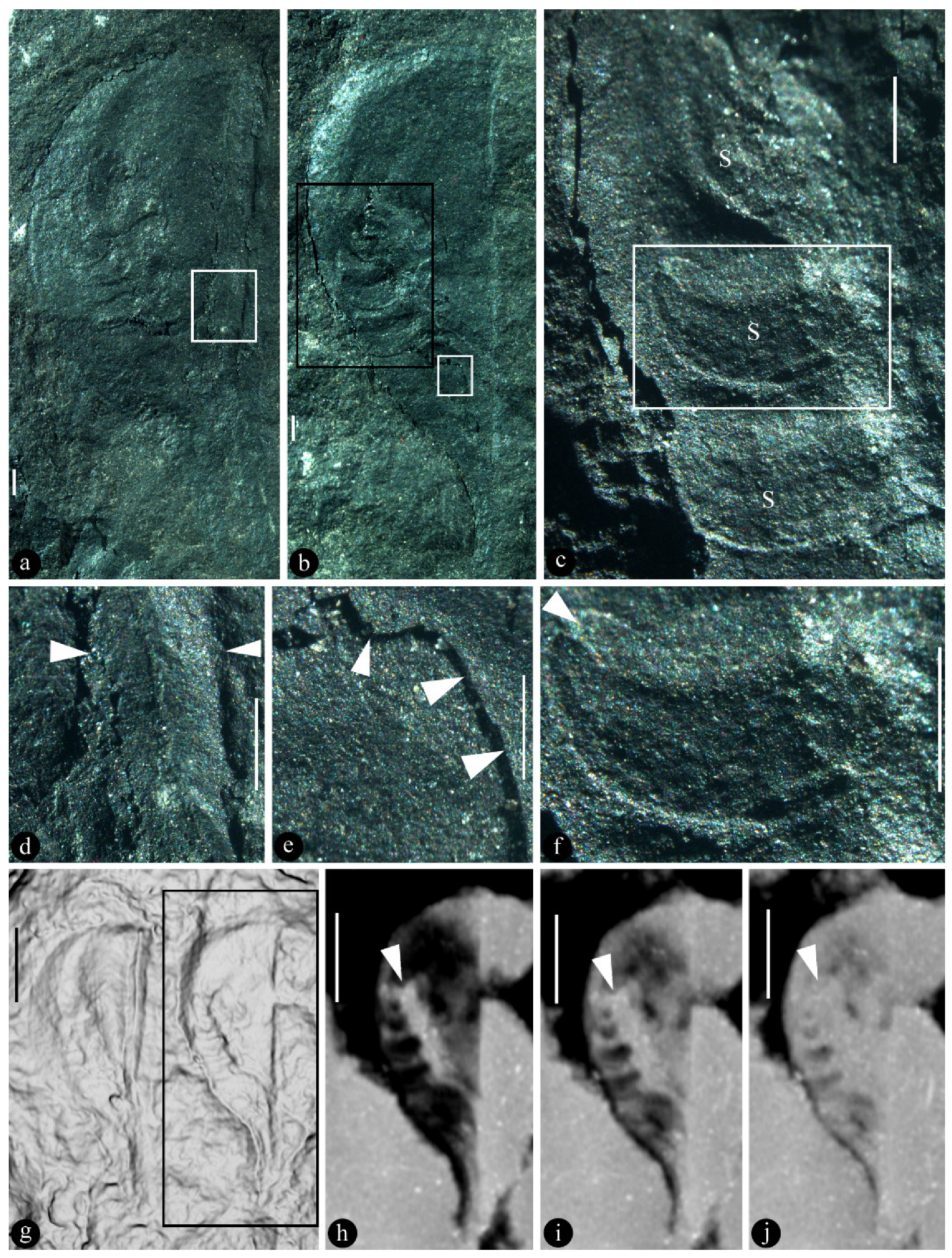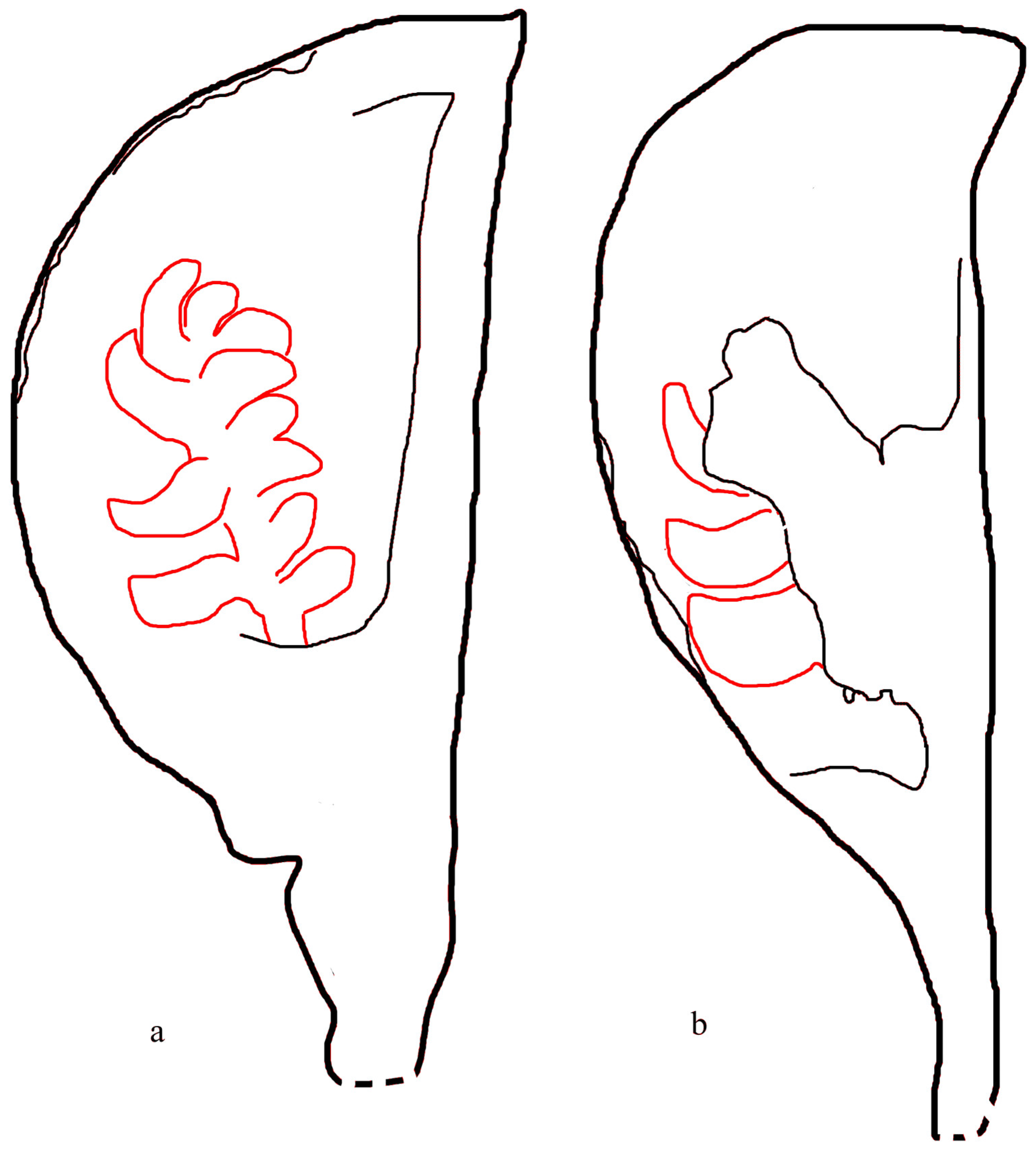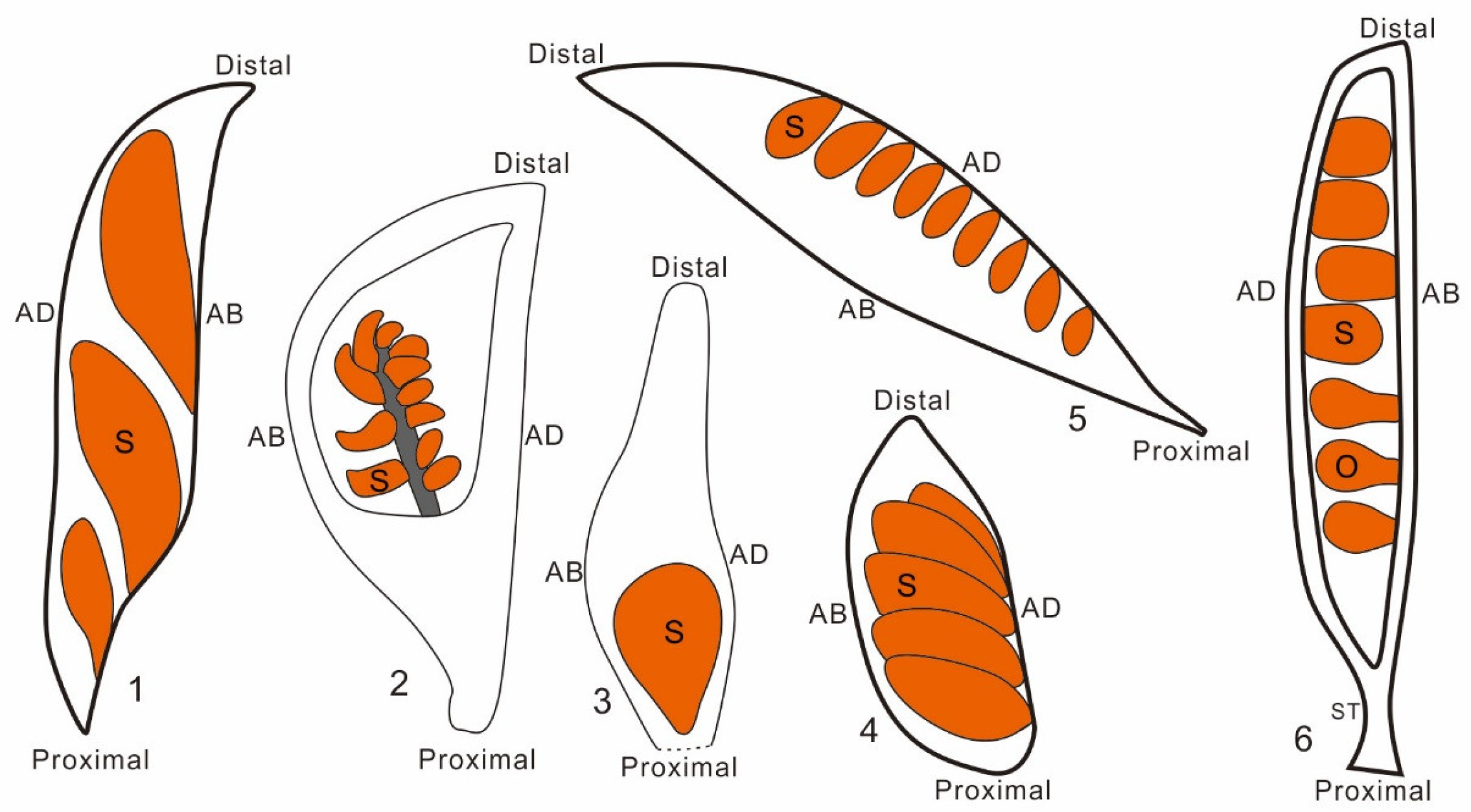Unique Jurassic Ovaries Shed a New Light on the Nature of Carpels
Abstract
1. Introduction
2. Materials and Methods
3. Results
4. Discussion
5. Conclusions
Author Contributions
Funding
Data Availability Statement
Acknowledgments
Conflicts of Interest
References
- Cronquist, A. The Evolution and Classification of Flowering Plants, 2nd ed.; New York Botanical Garden: Bronx, NY, USA, 1988; p. 555. [Google Scholar]
- Shivaprakash, K.N.; Bawa, K.S. The evolution of placentation in flowering plants: A possible role for kin selection. Front. Ecol. Evol. 2022, 10, 784077. [Google Scholar] [CrossRef]
- Wang, X.; Duan, S.; Geng, B.; Cui, J.; Yang, Y. Schmeissneria: A missing link to angiosperms? BMC Evol. Biol. 2007, 7, 14. [Google Scholar] [CrossRef] [PubMed]
- Wang, X. Schmeissneria: An angiosperm from the Early Jurassic. J. Syst. Evol. 2010, 48, 326–335. [Google Scholar] [CrossRef]
- Wang, X.; Wang, S. Xingxueanthus: An enigmatic Jurassic seed plant and its implications for the origin of angiospermy. Acta Geol. Sin. (Engl. Ed.) 2010, 84, 47–55. [Google Scholar] [CrossRef]
- Liu, Z.-J.; Wang, X. A perfect flower from the Jurassic of China. Hist. Biol. 2016, 28, 707–719. [Google Scholar] [CrossRef] [PubMed]
- Fu, Q.; Diez, J.B.; Pole, M.; Garcia-Avila, M.; Liu, Z.-J.; Chu, H.; Hou, Y.; Yin, P.; Zhang, G.-Q.; Du, K.; et al. An unexpected noncarpellate epigynous flower from the Jurassic of China. eLife 2018, 7, e38827. [Google Scholar] [CrossRef] [PubMed]
- Fu, Q.; Diez, J.B.; Pole, M.; García-Ávila, M.; Wang, X. Nanjinganthus is an angiosperm, isn’t it? China Geol. 2020, 3, 359–361. [Google Scholar] [CrossRef]
- Fu, Q.; Hou, Y.; Yin, P.; Diez, J.B.; Pole, M.; García-Ávila, M.; Wang, X. Micro-CT results exhibit ovules enclosed in the ovaries of Nanjinganthus. Sci. Rep. 2023, 13, 426. [Google Scholar] [CrossRef]
- Wang, X. The Dawn Angiosperms, 2nd ed.; Springer: Cham, Switzerland, 2018; p. 407. [Google Scholar]
- Zhang, X. Floral ontogeny of Illicium lanceolatum (Schisandraceae) and its implications on carpel homology. Phytotaxa 2019, 416, 200–210. [Google Scholar] [CrossRef]
- Zhang, X.; Liu, W.; Wang, X. How the ovules get enclosed in magnoliaceous carpels. PLoS ONE 2017, 12, e0174955. [Google Scholar] [CrossRef]
- Shi, G.; Leslie, A.B.; Herendeen, P.S.; Herrera, F.; Ichinnorov, N.; Takahashi, M.; Knopf, P.; Crane, P.R. Early Cretaceous Umkomasia from Mongolia: Implications for homology of corystosperm cupules. New Phytol. 2016, 210, 1418–1429. [Google Scholar] [CrossRef] [PubMed]
- Crane, P.R.; Herendeen, P.S.; Herrera, F.; Shi, G. Diversity and homologies of corystosperm seed-bearing structures from the Early Cretaceous of Mongolia and China. In 10th European Palaeobotany and Palynology Conference; McElwain, J., Ed.; Trinity College Dublin: Dublin, Ireland, 2018; p. 88. [Google Scholar]
- Endress, P.K. The morphological relationship between carpels and ovules in angiosperms: Pitfalls of morphological interpretation. Bot. J. Linn. Soc. 2019, 189, 201–227. [Google Scholar] [CrossRef]
- Sun, G.; Dilcher, D.L.; Zheng, S.; Zhou, Z. In search of the first flower: A Jurassic angiosperm, Archaefructus, from Northeast China. Science 1998, 282, 1692–1695. [Google Scholar] [CrossRef] [PubMed]
- Sun, G.; Ji, Q.; Dilcher, D.L.; Zheng, S.; Nixon, K.C.; Wang, X. Archaefructaceae, a new basal angiosperm family. Science 2002, 296, 899–904. [Google Scholar] [CrossRef] [PubMed]
- Ji, Q.; Li, H.; Bowe, M.; Liu, Y.; Taylor, D.W. Early Cretaceous Archaefructus eoflora sp. nov. with bisexual flowers from Beipiao, Western Liaoning, China. Acta Geol. Sin. (Engl. Ed.) 2004, 78, 883–896. [Google Scholar]
- Wang, X.; Zheng, X.-T. Reconsiderations on two characters of early angiosperm Archaefructus. Palaeoworld 2012, 21, 193–201. [Google Scholar] [CrossRef]
- Wang, X. New observation on seed/ovule position in the fruit of Archaeanthus and its systematic implications. China Geol. 2021, 4, 752–755. [Google Scholar] [CrossRef]
- Dilcher, D.L.; Crane, P.R. Archaeanthus: An early angiosperm from the Cenomanian of the Western Interior of North America. Ann. Mo. Bot. Gard. 1984, 71, 351–383. [Google Scholar] [CrossRef]
- Zheng, S.-L.; Zhang, W. Early and Middle Jurassic fossil flora from Tianshifu Liaoning. Liaoning Geol. 1990, 3, 212–237. [Google Scholar]
- Zheng, S.-L.; Zhang, W. Basic characteristics of Tianshifu Flora. Liaoning Geol. 1990, 4, 322–334. [Google Scholar]
- Harris, T.M. III. On Williamsoniella, a new type of bennettitalean flower. Philos. Trans. R. Soc. Lond. Ser. B 1916, 207, 335–347. [Google Scholar]
- Harris, T.M. Williamsoniella lignieri: Its pollen and the compression of spherical pollen grains. Palaeontology 1974, 17, 125–148. [Google Scholar]
- Cronquist, A.; Berry, P.E.; Zimmermann, M.H.; Dilcher, D.L.; Stevens, P.; Stevenson, D.W. Angiosperm. Available online: https://www.britannica.com/plant/angiosperm (accessed on 8 July 2024).
- Wang, X. Criterion is a touchstone in study of early angiosperms. Open J. Plant Sci. 2021, 6, 91–93. [Google Scholar] [CrossRef]
- Wang, X. A novel Early Cretaceous flower and its implications on flower derivation. Biology 2022, 11, 1036. [Google Scholar] [CrossRef] [PubMed]
- Wang, X.; Shih, C.; Liu, Z.-J.; Lin, L.; Singh, K.J. Reconstructing the Callianthus plant–An early aquatic angiosperm from the Lower Cretaceous of China. Cretac. Res. 2021, 128, 104983. [Google Scholar] [CrossRef]
- Han, G.; Fu, X.; Liu, Z.-J.; Wang, X. A new angiosperm genus from the Lower Cretaceous Yixian Formation, Western Liaoning, China. Acta Geol. Sin. (Engl. Ed.) 2013, 87, 916–925. [Google Scholar]
- Han, G.; Liu, Z.; Wang, X. A Dichocarpum-like angiosperm from the Early Cretaceous of China. Acta Geol. Sin. (Engl. Ed.) 2017, 90, 1–8. [Google Scholar]
- Han, G.; Wang, X. A new infructescence of angiosperms from the Early Cretaceous of China. Acta Geol. Sin. (Engl. Ed.) 2020, 94, 1711–1713. [Google Scholar] [CrossRef]
- Liu, X.; Ma, L.; Liu, B.; Liu, Z.-J.; Wang, X. A novel angiosperm including various parts from the Early Cretaceous sheds new light on flower evolution. Hist. Biol. 2021, 33, 2706–2714. [Google Scholar] [CrossRef]
- Liu, Z.-J.; Wang, X. Yuhania: A unique angiosperm from the Middle Jurassic of Inner Mongolia, China. Hist. Biol. 2017, 29, 431–441. [Google Scholar] [CrossRef]
- Liu, Z.-J.; Wang, X. A novel angiosperm from the Early Cretaceous and its implications on carpel-deriving. Acta Geol. Sin. (Engl. Ed.) 2018, 92, 1293–1298. [Google Scholar] [CrossRef]
- Han, L.; Zhao, Y.; Zhao, M.; Sun, J.; Sun, B.; Wang, X. New fossil evidence suggests that angiosperms flourished in the Middle Jurassic. Life 2023, 13, 819. [Google Scholar] [CrossRef] [PubMed]
- Puri, V. Placentation in angiosperms. Bot. Rev. 1952, 18, 603–651. [Google Scholar] [CrossRef]
- Stebbins, G.L. Flowering Plants: Evolution above Species Level; Harvard University Press: Cambridge, UK, 1974. [Google Scholar]
- Edwards, D. Embryophytic sporophytes in the Rhynie and Windyeld cherts. Trans. R. Soc. Edinb. Earth Sci. 2003, 94, 397–410. [Google Scholar] [CrossRef]
- Hao, S.; Xue, J. The Early Devonian Posongchong Flora of Yunnan; Science Press: Beijing, China, 2013; p. 366. [Google Scholar]
- Hao, S.; Xue, J. Earliest record of megaphylls and leafy structures, and their initial diversification. Chin. Sci. Bull. 2013, 58, 2784–2793. [Google Scholar] [CrossRef][Green Version]
- Wang, D.-M.; Xu, H.-H.; Xue, J.-Z.; Wang, Q.; Liu, L. Leaf evolution in early-diverging ferns: Insights from a new fern-like plant from the Late Devonian of China. Ann. Bot. 2015, 115, 1133–1148. [Google Scholar] [CrossRef]
- Wang, D.-M.; Liu, L.; Meng, M.-C.; Xue, J.-Z.; Liu, T.; Guo, Y. Cosmosperma polyloba gen. et sp. nov., a seed plant from the Upper Devonian of South China. Naturwissenschaften 2014, 101, 615–622. [Google Scholar] [CrossRef]
- Wang, D.-M.; Liu, L.; Zhou, Y.; Qin, M.; Meng, M.-C.; Guo, Y.; Xue, J.-Z. Guazia, the earliest ovule without cupule but with unique integumentary lobes. Natl. Sci. Rev. 2022, 9, nwab196. [Google Scholar] [CrossRef]
- Wang, X.; Luo, B. Mechanical pressure, not genes, makes ovulate parts leaf-like in Cycas. Am. J. Plant Sci. 2013, 4, 53–57. [Google Scholar] [CrossRef]
- Miao, Y.; Liu, Z.J.; Wang, M.; Wang, X. Fossil and living cycads say “No more megasporophylls”. J. Morphol. Anat. 2017, 1, 107. [Google Scholar]
- Eames, A.J. The relationships of Ephedrales. Phytomorphology 1952, 2, 79–100. [Google Scholar]
- Rothwell, G.W.; Stockey, R.A. Evolution and phylogeny of Gnetophytes: Evidence from the anatomically preserved seed cone Protoephedrites eamesii gen. et sp. nov. and the seeds of several Bennettitalean species. Int. J. Plant Sci. 2013, 174, 511–529. [Google Scholar] [CrossRef]
- Florin, R. Die Koniferen des Oberkarbons und des unteren Perms. Paläontograph. B 1944, 85, 457–654. [Google Scholar]
- Florin, R. Evolution in cordaites and conifers. Acta Horti Bergiani 1951, 15, 285–388. [Google Scholar]
- Roe, J.L.; Nemhauser, J.L.; Zambryski, P.C. TOUSLED participates in apical tissue formation during gynoecium development in Arabidopsis. Plant Cell 1997, 9, 335–353. [Google Scholar]
- Rounsley, S.D.; Ditta, G.S.; Yanofsky, M.F. Diverse roles for MADS box genes in Arabidopsis development. Plant Cell 1995, 7, 1259–1269. [Google Scholar]
- Skinner, D.J.; Hill, T.A.; Gasser, C.S. Regulation of ovule development. Plant Cell 2004, 16 (Suppl. S1), S32–S45. [Google Scholar] [CrossRef]
- Mathews, S.; Kramer, E.M. The evolution of reproductive structures in seed plants: A re-examination based on insights from developmental genetics. New Phytol. 2012, 194, 910–923. [Google Scholar] [CrossRef]
- Leng, Q.; Friis, E.M. Sinocarpus decussatus gen. et sp. nov., a new angiosperm with basally syncarpous fruits from the Yixian Formation of Northeast China. Plant Syst. Evol. 2003, 241, 77–88. [Google Scholar] [CrossRef]
- Leng, Q.; Friis, E.M. Angiosperm leaves associated with Sinocarpus infructescences from the Yixian Formation (Mid-Early Cretaceous) of NE China. Plant Syst. Evol. 2006, 262, 173–187. [Google Scholar] [CrossRef]
- Du, B.; Zhang, M.; Sun, B.; Li, A.; Zhang, J.; Yan, D.; Xie, S.; Wu, J. An exceptionally well-preserved herbaceous eudicot from the Early Cretaceous (late Aptian-early Albian) of Northwest China. Natl. Sci. Rev. 2021, 8, nwab084. [Google Scholar] [CrossRef] [PubMed]
- Endress, P.K. Multicarpellate gynoecia in angiosperms: Occurrence, development, organization and architectural constraints. Bot. J. Linn. Soc. 2014, 174, 1–43. [Google Scholar] [CrossRef]
- Martin, W.; Gierl, A.; Saedler, H. Molecular evidence for pre-Cretaceous angiosperm origins. Nature 1989, 339, 46–48. [Google Scholar] [CrossRef]
- Martin, W.; Gierl, A.; Saedler, H. Angiosperm origins. Nature 1989, 342, 132. [Google Scholar] [CrossRef]
- Soltis, D.E.; Bell, C.D.; Kim, S.; Soltis, P.S. Origin and early evolution of angiosperms. Ann. N. Y. Acad. Sci. 2008, 1133, 3–25. [Google Scholar] [CrossRef]
- Soltis, P.S.; Soltis, D.E. The origin and diversification of angiosperms. Am. J. Bot. 2004, 91, 1614–1626. [Google Scholar] [CrossRef]
- Li, H.-T.; Yi, T.-S.; Gao, L.-M.; Ma, P.-F.; Zhang, T.; Yang, J.-B.; Gitzendanner, M.A.; Fritsch, P.W.; Cai, J.; Luo, Y.; et al. Origin of angiosperms and the puzzle of the Jurassic gap. Nat. Plants 2019, 5, 461–470. [Google Scholar] [CrossRef]
- Zuntini, A.R.; Carruthers, T.; Maurin, O.; Bailey, P.C.; Leempoel, K.; Brewer, G.E.; Epitawalage, N.; Françoso, E.; Gallego-Paramo, B.; McGinnie, C.; et al. Phylogenomics and the rise of the angiosperms. Nature 2024, 629, 843–850. [Google Scholar] [CrossRef]
- Mandel, J.R. A Jurassic leap for flowering plants. Nat. Plants 2019, 5, 455–456. [Google Scholar] [CrossRef]
- Herendeen, P.S.; Friis, E.M.; Pedersen, K.R.; Crane, P.R. Palaeobotanical redux: Revisiting the age of the angiosperms. Nat. Plants 2017, 3, 17015. [Google Scholar] [CrossRef]
- Hochuli, P.A.; Feist-Burkhardt, S. A boreal early cradle of angiosperms? angiosperm-like pollen from the Middle Triassic of the Barents Sea (Norway). J. Micropalaeontol. 2004, 23, 97–104. [Google Scholar] [CrossRef]
- Hochuli, P.A.; Feist-Burkhardt, S. Angiosperm-like pollen and Afropollis from the Middle Triassic (Anisian) of the Germanic Basin (Northern Switzerland). Front. Plant Sci. 2013, 4, 344. [Google Scholar] [CrossRef]
- Prasad, V.; Strömberg, C.A.E.; Leaché, A.D.; Samant, B.; Patnaik, R.; Tang, L.; Mohabey, D.M.; Ge, S.; Sahni, A. Late Cretaceous origin of the rice tribe provides evidence for early diversification in Poaceae. Nat. Commun. 2011, 2, 480. [Google Scholar] [CrossRef] [PubMed]
- Wu, Y.; You, H.-L.; Li, X.-Q. Dinosaur-associated Poaceae epidermis and phytoliths from the Early Cretaceous of China. Natl. Sci. Rev. 2018, 5, 721–727. [Google Scholar] [CrossRef]
- Wu, Z.-Y.; Lu, A.-M.; Tang, Y.-C.; Chen, Z.-D.; Li, D.-Z. Synopsis of a new “polyphyletic-polychronic-polytopic” system of the angiosperms. Acta Phytotaxon. Sin. 2002, 40, 289–322. [Google Scholar]
- Han, G.; Liu, Z.-J.; Liu, X.; Mao, L.; Jacques, F.M.B.; Wang, X. A whole plant herbaceous angiosperm from the Middle Jurassic of China. Acta Geol. Sin. (Engl. Ed.) 2016, 90, 19–29. [Google Scholar]
- Cui, D.-F.; Hou, Y.; Yin, P.; Wang, X. A Jurassic flower bud from China. Geol. Soc. Lond. Spec. Publ. 2022, 521, 81–93. [Google Scholar] [CrossRef]
- Wang, X.; Fu, Q. Taiyuanostachya: An abominable angiosperm from the Early Permian of China. J. Biotechnol. Biomed. 2023, 6, 371–379. [Google Scholar] [CrossRef]



Disclaimer/Publisher’s Note: The statements, opinions and data contained in all publications are solely those of the individual author(s) and contributor(s) and not of MDPI and/or the editor(s). MDPI and/or the editor(s) disclaim responsibility for any injury to people or property resulting from any ideas, methods, instructions or products referred to in the content. |
© 2024 by the authors. Licensee MDPI, Basel, Switzerland. This article is an open access article distributed under the terms and conditions of the Creative Commons Attribution (CC BY) license (https://creativecommons.org/licenses/by/4.0/).
Share and Cite
Fu, Q.; Sun, J.; Zheng, S.; Wang, X. Unique Jurassic Ovaries Shed a New Light on the Nature of Carpels. Plants 2024, 13, 2239. https://doi.org/10.3390/plants13162239
Fu Q, Sun J, Zheng S, Wang X. Unique Jurassic Ovaries Shed a New Light on the Nature of Carpels. Plants. 2024; 13(16):2239. https://doi.org/10.3390/plants13162239
Chicago/Turabian StyleFu, Qiang, Jie Sun, Shaolin Zheng, and Xin Wang. 2024. "Unique Jurassic Ovaries Shed a New Light on the Nature of Carpels" Plants 13, no. 16: 2239. https://doi.org/10.3390/plants13162239
APA StyleFu, Q., Sun, J., Zheng, S., & Wang, X. (2024). Unique Jurassic Ovaries Shed a New Light on the Nature of Carpels. Plants, 13(16), 2239. https://doi.org/10.3390/plants13162239






